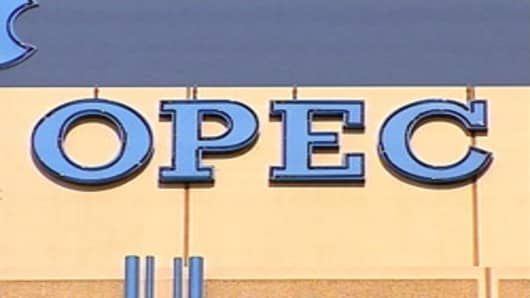Ministers of the Organization of the Petroleum Exporting Countries (OPEC) had been widely expected to stick to existing production allocations, which have been in place all year and are still theoretically unchanged.
There had been expectations real supply above targets would be discreetly pared back, although few had expected any change to be made public.
OPEC President Chakib Khelil said Wednesday's decision amounted to a cut from the group's actual July output.
"I think if you do your own calculation properly, it will be a lowering of production by about 520,000 barrels per day," Khelil said.
U.S. crude prices initially rose by around a dollar, but later slipped to around $103 a barrel, almost unchanged from the previous close.
Russia Moves Closer
The other surprise was that major energy producer Russia, which attends OPEC conferences as an observer, sent a very senior official, the influential deputy prime minister Igor Sechin.
Analysts linked his attendance to tension between Russia and the West over Moscow's conflict with Georgia.
Russia's energy ministry said Russia wanted to hold regular dialogue with OPEC and had invited representatives to Moscow for a meeting in October.
In the past, Russia has agreed to trim production in line with OPEC output cuts to support prices.
Khelil's estimation of how much output will be removed from the market derived from amounts OPEC members were really producing, rather than agreed limits.
OPEC's new production ceiling is 28.8 million bpd, compared with its earlier target of 29.67 million bpd, ministers said.
But because Indonesia's membership is suspended from Jan. 1, its allocation has been subtracted, meaning the output ceiling is essentially unchanged.
"The communique is much as expected," said Paul Horsnell of Barclays Capital. "However, it also talks of strictly adhering to quotas, when we might have expected the trimming back in coming months to be done more discreetly."
Others agreed the only surprise element was that OPEC has made public its intention to remove supply above agreed limits.
"The statement is clear as mud, but really what it says is members should keep to quota, which basically means Saudi Arabia should stop the additional barrels that it has provided over the summer, which was somehow expected," said Olivier Jakob of Petromatrix.
"I would say it's only half of a surprise because they have made a formal announcement."
Targets vs. Actual Production
OPEC was estimated to be pumping roughly 790,000 bpd above its agreed target, the bulk of which came from Saudi Arabia.
At a specially convened meeting in Jeddah in June, the leading exporter announced unilaterally that it would pump 9.7 million bpd, around 750,000 bpd above its agreed ceiling.
The kingdom said it was responding to strong consumption and a senior Gulf source said on Tuesday he expected it to continue producing at around 9.7 million bpd if demand held steady.
"The market is fairly well-balanced and we have worked very hard since the June meeting to bring prices to where they are now. I think we have been very successful," Saudi Oil Minister Ali al-Naimi told reporters on arrival in Vienna on Tuesday.
He has yet to comment following OPEC's output decision, which was announced at around 3 a.m. New York time on Wednesday morning following a meeting that did not begin until after 10 p.m. on Tuesday because of Ramadan fasting.
Ahead of the conference, most OPEC ministers had seemed broadly happy with the oil price and had indicated there was probably no need for urgent action, although some -- including Iran, Libya, Venezuela and Algeria—said there was a risk the market could become oversupplied.
"While we believe that Saudi Arabia would be perfectly happy with prices in the $90 to $100 range, it seems that other OPEC members wished to give a slightly stronger signal. For those members, it appears that the $100 level is shaping up as a sort of soft floor," Horsnell said.
OPEC will further review its production policy at a meeting in Algeria on Dec. 17.


